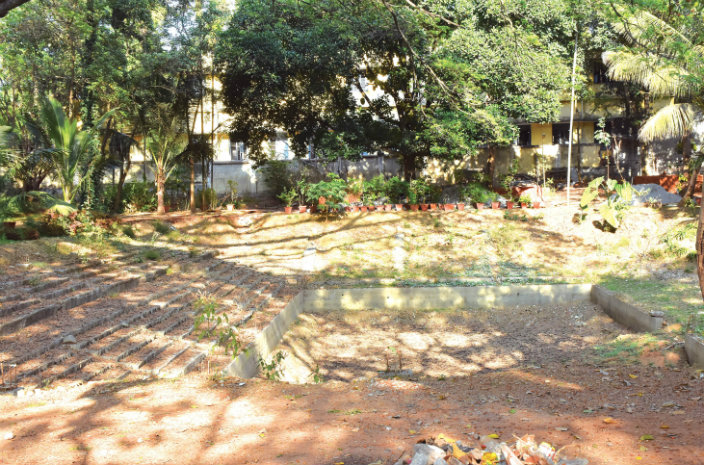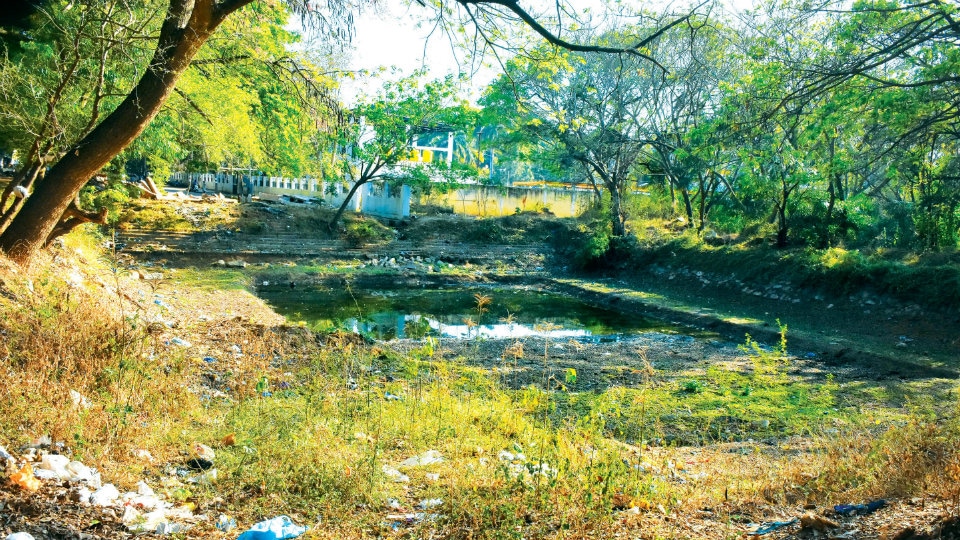Mysuru/Mysore: Long before becoming a big city, Mysuru was known for its Kalyanis (ancient step ponds) or temple tanks. Many historians called Mysuru as a place for springs, natural tanks and Kalyanis. Over the years, the heritage Kalyanis, lakes and open wells have become the first casualty of development. Most of them are now either built upon or dumped with debris.
Covered with growth of thorny bushes and weeds over the years, there are two Kalyanis or stone wells that once brimmed with fresh water. Locals fetched clean drinking from here. But now, both of these important water sources are filled with foul-smelling waste surrounded by construction debris and plastic.
In fact, these two Kalyanis are not located far from the sight of our officials and the political class who often wax eloquent on protecting our nature and surroundings. They are very much in the middle of our Heritage City. While one is situated at Chandravana, a nursery maintained by Government Ayurveda College near Kukkarahalli Lake, the other one is located just steps away from this place near the Swimming Pool of University of Mysore.

Due to years of neglect, the ancient Kalyanis are in decrepit condition and did not serve its purpose for storing clean water. Continuous dumping of waste has turned the tanks into a dumping-ground infested with rodents. The Kalyanis are filled with overgrown weeds and heavy silting and the steps leading to the bottom of the Kalyanis are in a state of disrepair.
Built during the reign of Mysuru Maharajas, probably during construction of Kukkarahalli Lake, these two Kalyanis catered the needs of people living in nearby villagers and also increased underground water levels. Local residents allege that officials and their departments have completely ignored these two monuments.
Now, drainage water flowing from three to four sewage lines is filling these two Kalyanis. A little rain is enough to flood these two pools with foul-smelling water. Every day, in particular Saturdays, hundreds of people visit Shani Mahatma temple located nearby and they have to bear this malodour and ugly sight of this place.
Nazarbad resident M.R. Ashok Kumar said, “In the very near future, this neglected place will be encroached upon. Both district administration and Mysuru City Corporation have turned a blind eye to this issue. Earlier, there was a plan to make a Lal Bagh here on the lines of Bengaluru Lal Bagh. Forget Lal Bagh, there is a grave danger of the place being encroached.”
If the Kalyanis are revived, groundwater recharge covering about a 5-mile radius in the surrounding area can be achieved and aesthetic surroundings for the benefit and enjoyment of the local community can be achieved, he added.
Thanks to the near-constant drought, about three-quarters of the estimated 39,000 traditional Kalyanis and tanks that existed two decades ago across the State have either dried up, been encroached upon or have been turned into sewage dumps, leading to an alarming fall in groundwater levels.
These are historically important structures. These Kalyanis also revive underground water table in an effective way. Most importantly, efforts should be made to conserve and restore the identity of these two Kalyanis both for people who live nearby to breathe fresh air in these polluted surroundings and for the future generation, urge people.
Mysuru has lost many good things of the past in the name of development. On rough estimates, we have lost at least 8-10 Kalyanis in the heart of city in just the last 15 years. The main problem is that we have no proper record of what we had in the past, historians say.








Recent Comments